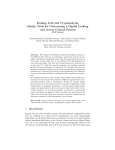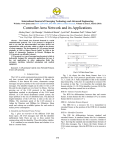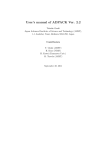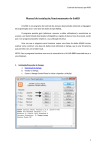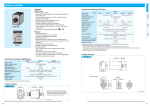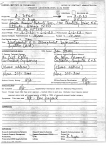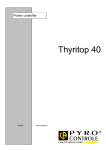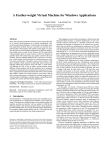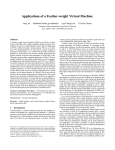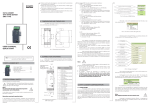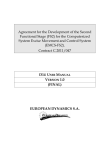Download Introduction to Virtualization
Transcript
Introduction to Virtualization Dr. Qingni Shen Peking University Intel UPO Supported Main Points Status and trends in data center Definition of virtualization Common types of virtualization Key technologies of sever virtualization Mainstream virtualization softwares and the practice of virtualization technology IT resource allocation mode of traditional data center --the Chimney structure Department A Department Z Department B App 1 App 2 App 3 App n Server 1 Server 2 Server 3 Server n …………………. Data network and storage network Infrastructure 3 Defects of traditional chimney data center 100% 80% large amount of processing ability which is fail to use Servers of lack of processing ability 60% 40% 20% 0% All servers • Defect 1:According to the statistics, the average server utilization in data center is below 30%, but there is still a considerable number of servers can not meet their service level objects . • Defect 2:The deployment of a new application needs budget, procurement, installation and tests, product launching and other processes, and the cycle will be over a period of weeks to months, so it is difficult to response to the business needs timely. • Defect 3:The number of servers and management costs have a linear relationship with the number of applications, so there is enormous pressure of IT management 4 and cost. Causes of low resource utilization Required number of CPU Over configure the servers to cope with a small amount of peak load Time 5 “Iceberg Model” -- Cost structure of traditional data center Visible cost: 30% of the budget will be used in new infrastructure and new application development Invisible cost: 70% of the budget will be used in the maintenance of existing facilities and personnel expenses Question: How to save the operation expenditure budget for more IT infrastructure innovation? 6 IT infrastructure development in data center Three stages Data network LAN WAN MAN storage network Server interconnection network Storage network HPC cluster grid Intelligent information Network (IIN) Application System Dynamic Provisioning and Information Lifecycle Management (ILM) to Enable Business Agility Virtualization Management of Resources Independent of Underlying Physical Infrastructure to Increase Utilization, Efficiency and Flexibility Business Policies On-Demand Service Oriented Computing resources Network resources Integration Centralization and Standardization to Lower Costs, Improve Efficiency and Uptime Automation Computing Network resources resource Storage resource Storage resources On-demand data center SCM ERP CRM Non-virtual Environment Isolated techno-island LAN WAN Internet Complex management system Resource are not shared Huge architecture HP Difficult to configure a new workload Rigid and not inflexible SCM ERP CRM Virtual Environment VHCI VPN General technical platform Easy management system Shared resource library Virtual Server Simple architecture Easy to configure the new workload Virtual Storage On-demand and flexible Main Points Status and trends in data center Definition of virtualization Common types of virtualization Key technologies of sever virtualization Mainstream virtualization softwares and the practice of virtualization technology Definition of Virtualization Nature of virtualization: Previous computing system or components that run in real environment are now running in virtual environment. Real computing model Virtual Computing model APP APP Operating System CPU Hard Disk Memory I/O Devices APP APP APP APP Operating System Operating System Virtual Execution Environment Virtual Execution Environment CPU Memory Hard Disk I/O Devices Definition of Virtualization Definition Nature of virtualization: computing system or Virtualization is an abstraction of Previous computer resources. We components thatresources run in real running virtual can access in environment a consistentare waynow before and inafter environment. abstraction through virtualization. This kind of resource Real computing model Virtual Computing model abstraction is not limited by implementation, geographical location or the underlying physical configuration. APP APP Operating System CPU Hard Disk Memory I/O Devices APP APP APP APP Operating System Operating System Virtual Execution Environment Virtual Execution Environment CPU Memory Hard Disk I/O Devices Main Points Status and trends in data center Definition of virtualization Common types of virtualization Key technologies of sever virtualization Mainstream virtualization softwares and the practice of virtualization technology Common types of Virtualization Types: Infrastructure Virtualization、System Virtualization、Software Virtualization. Infrastructure Virtualization Network Virtualization: Integrate network hardware resources with software resources to provide users with virtualization technology of virtual network connection. It can be divided into VLAN and VPN. Storage Virtualization: Provide an abstract logical view of physical storage device, so the user can access the integrated storage resources through unified logical interface of this view. It can be divided into storage device based storage virtualization(eg RAID) and network based storage virtualization(eg NAS, SAN). System Virtualization Core idea:Create one or more virtual machines using virtualization software on physical machine. PC/Server Virtualization:The maximum value of system virtualization. Desktop Virtualization : Solve the coupling relationship between PC desktop environment(including applications and files, etc.) and physical machines. Virtualized desktop environment is stored on a remote server, and when user has compatible device with sufficient display ability(eg PC, Smart Phones, etc.), all the programs and data will eventually stored in the remote server. Software Virtualization The High-level language virtualization:Solve the migration problem of executable programs between different architectures. Programs which are written in high-level language will be compiled into standard intermediate instructions, and these instructions will be executed during interpretation or compiled environment(such as Java virtual machine JVM) Application Virtualization:Decouple applications from operation systems, and provide a virtual running environment for applications, including application executable files and required runtime environment. Application virtualization server can push user required program components to the client virtual running environment timely(such as VMWare ThinApp). Categories of Virtualization Technology VMWare ThinApp… Application level virtualization JVM (Java VM) Application API Program Library Programming language level virtualization WINE… Program library level virtualization Jail, Enism… System Calls Operating System ISA Instruction Set Hardware Computer System Operating system level virtualization Bochs, QEMU… Instruction level virtualizationVMWare, Xen, Virtual PC… Hardware level virtualization Main Points Status and trends in data center Definition of virtualization Common types of virtualization Key technologies of sever virtualization Mainstream virtualization softwares practice of virtualization technology and the Server virtualization technology Convenient to manage; Improve the utilization rate; reduce cost; focus on skills Purchase the needed only Simplify the environment Concentrate on core skills Improve the response speed of business change DNS server average utilization rate is 10%? File/Print Server Web Server average utilization rate is 10%? average utilization rate is 10%? Email server average utilization rate is 10%? Application Server average utilization rate is 20%? DB® Server App Server Web Server DNS Server Firewall average utilization rate is 10% ? Server average utilization rate is 10%? File/Print Email Firewall Virtualization technology is the core of cloud computing Lower IT cost Higher utilization rate Less complexity More automatic management Exchange File/Print SAP ERP Oracle CRM Storage Pool Virtual Infrastructure Higher quality of service – Support dynamic migration – Better fault tolerance – With isolation, better safety – Container based management, have encapsulation – Flexible, easy to expand Cloud Computing Platform CPU Pool Storage Pool Development of virtualization technology The virtual machine technology firstly appeared in the last 60’s in order to improve the utilization rate of precious computing resources impel the wide study and use of virtual machine technology 20 In the 80’s and 90’s with the popularization of multitask and multiuser operating system and the decline in the cost of hardware virtual machine technology could not develop its advantage people cooled down their study enthusiasm for it 21 Now, Based on the high performance of the computer hardware how to reduce system cost and improve system resource utilization rate how to reduce management cost how to enhance the safety and reliability how to improve portability, and increase software development efficiency make the importance of virtual machine technology more obvious make virtual machine technology become the research 22 hotspot again Architecture of Virtualization Technology 23 Virtual machine system is realized by adding a virtual layer VMM(virtual Machine Monitor or Hypervisor) to an existing platform(bare computer or operating system) VMM A system software, which can maintain multiple efficient and isolated program environment. VMM manages the real resources of computer system, and provides interface for virtual machines. VM(Virtual Machine) A complete computer system with full functions of hardware system through software simulation, and runs in an absolutely isolated environment. Host OS Some VMMs are installed on existing OS which is called the host OS. 24 Classification of Virtualization implementation technologies Ring 3 Full Virtualization Guest Application Ring 2 Ring 1 Ring 0 Guest OS Hypervisor OS requests binary translation It uses a kind of technology called Binary Translation。The core idea is that the hypervisor runs in ring 0, which is responsible for the management of the underlying hardware. Guest OS runs in ring 1, and when they call the privileged instructions, VMM in the ring 0 will uses binary translation to stop these instructions and is responsible for the following work of the instructions. Disadvantages: Hardware software interception mechanism, high performance overhead 25 Ring 3 Ring 2 Ring 1 Ring 0 Para-virtualization Guest Application Paravirtualization Guest OS Hypervisor Guest OS can still run in ring 0, but we need to modify the OS kernel. The call for the privileged instructions calls into the hypervisor, which is called Hypercall. A typical representative of para-virtualization is Xen. So, when guest OS in the ring 0 calls privileged instructions, it will Implementation turn into Hypercall, but hypervisor of privileged still supervises the system hardware operations by resources. the Hypercall Instruction Hardware Disadvantage: The need to modify OS kernel. 26 Ring 3 Guest Application Ring 2 Non-root mode Ring 1 Ring 0 Root mode Guest OS Hypervisor Hardware Hardware-assisted Virtualization CPU needs to support virtualization technology. Besides ring 0 to ring 3, CPU needs to provide an additional ring for Hypervisor only, calling ring -1。 Guest OS still runs in ring 0, but when OS calls privileged instructions, they will be turned to Hypervisor in the ring -1 through hardware mechanism, and the Hypervisor manages the hardware. OS’s requests trap into Hypervisor. Disadvantages: No binary Need hardware support.(such translation or as Intel VT, AMD SVM) paravirtuali 27 -zation Classification of VMM Hosted -Need to run on provides the driver communication UMLinux, User-Mode Linux. Host OS, which and hardware Independent monitoring-Run directly on hardware layer VMware’s ESX Server. Xen Hybrid VMWare Workstation Classification of VMM-I、II 29 Classification of VMM 30 The implementation technology of VMM CPU Virtualization Memory Virtualization I/O Virtualization CPU Virtualization Traditional CPU level classification The x86 processor responses to 4 different priority, called ring 0 to ring 3. Ring 0 has the highest priority, and ring 3 has the lowest priority. Ring 0 is used for OS kernel, ring 1 and ring 2 are used for OS services, and ring 3 is used for applications. Privileged and non-privileged instructions The instruction set is usually divided into two kinds of instructions, which are non-privileged and privileged instructions. Non-privileged does not change the value or state of shared resources。 Shared resources include processor, memory, timer, and registers of special purposes. Non-privileged instructions include arithmetic instructions、logic instructions, and so on. Privileged instructions are all used to access the value or state of shared resources,including shutdown, set the timer, set the program counter, change the value of the relocation register and instructions associated with I/O。 Non-privileged instructions can be directly executed by VMM, while the privileged instructions require simulation execution. Difficulties of the CPU classification in virtual system Generally speaking, Host OS should run in Ring 0, but in order to avoid the destruction to Host OS by Guest OS , Guest OS must run under Ring 0(such as Ring 1). The problem is that, in order to realize the full system functions of Guest OS, the thread must be in Ring 0. So virtual software needs to coordinate with Guest OS and Host OS of the thread priority, and this kind of transformation will inevitably increase system complexity,which leads to poor performance of software virtual technology, and the processing ability of CPU and memory will be largely spent during this process. Data shows that this kind of degradation of system performance will be 5% to 40%. Hardware CPU virtualization • In order to improve the efficiency of CPU virtualization, we need to use hardware to realize the switch of different levels. • In the field of server, CPU can put VMM in ring -1. • Thus, Intel and AMD develop VT-x and AMD-V technology respectively, realizing the isolation between VMM and Guest OS with the help of CPU. Memory Virtualization VMM must has the ultimate control of physical memory, that is to say, it must control the operation of mapping guest physical address space to host address space. In this way, we can realize memory virtualization. Method of memory virtualization VMM maintains a virtual machine memory management data structure --shadow page table. VMM allocates memory pages to different virtual machines through shadow page table. Like OS virtual memory, VMM can map virtual machine memory pages to disk, so virtual machine can apply for more memory than machine physical memory. VMM is also able to allocate memory dynamically according to each virtual machine’s requirements. Frequent change to page tables by OS increases the overhead of updating the shadow page table operation, so using hardware to manage shadow page table will be the future research direction. I/O Virtualization Hosted I/O Virtualization With the structure of host, and use drivers of hosted OS’s I/O device. Disadvantages: It greatly increases the performance overhead of virtualization. Modern OSs such as Windows and Linux have no support for resources management to provide performance isolation and service assurance, which are basic requirements of many server environment. Page 39 Hardware I/O Virtualization The trend of I/O subsystem is toward the direction of the development of hardware support. It is possible to transmit I/O device to software in virtual machines directly with enough hardware support. This will effectively eliminates all I/O virtual overhead. To do this, I/O device needs to get hold of virtual machine and support multiple virtual interface, so that VMM can safely map interface to virtual machine. Intel VT-d is the representative of hardware I/O Page 40 virtualization Main Points Status and trends in data center Definition of virtualization Common types of virtualization Key technologies of sever virtualization Mainstream virtualization softwares and the practice of virtualization technology Mainstream virtualization softwares VMWare: Not open source •VMware-ESX-Server Can directly run on top of hardware without host OS. In fact, it is a modified Linux kernel. •VMware-WorkStation, VMware-GSX-Server Need host OS Xen: Open source Xen virtual machine which is also called Xen VMM, is an open source project developed by computer laboratory of Cambridge University. Xen virtual machine has two kinds of operation modes: Full virtualization Para virtualization Hardware support for virtualization INTEL VT series VT-x: Virtualization Technology for IA-32 Processor assisted virtualization VT-d: Virtualization Technology for Directed I/O I/O assisted virtualization: direct I/O VT-c: Virtualization Technology for Connectivity Network assisted virtualization TXT- Trusted Execution Technology Practice of virtualization technology Tasks:Choose one of the following topics. VM name of each group should be unified as follows: Group Number + Crew initials +VM Sequence number For example : The second VM of group one should be name 1zslswwzl2 while all the members are Zhang Shan, Li Si, Wang Wu and Zhao Liu. Please screenshot the name. 1.Install an operating system in virtual platform, and create an account (Degree of difficulty☺) 1-2 people per group 2.Establish a ftp connection between two OSes in virtual platform(Degree of difficulty☺☺) 2-5 people per group 3.Build virtual platform on the OS on virtual platform, and install an OS on it. (Degree of difficulty☺☺☺) 5-7 people per group Experimental purposes 1>Understand the concept of virtualization 2> Master how to set-up and use virtual machine 3> Understand the way of establishing a network connection between VMs(2) 4> Understand basic operations of Vmware and Xen, and how to install OS on them.(3) Experimental requiremnt 1>Install a Virtual machine Monitor. 2>Install OS on virtual platform 3>Establish a ftp connection between VMs(2) 4>Build a virtual platform on the VM on virtual platform , and install os on it.(3) 5>Write lab reports, screenshots and proper interpretation of each step is required. Resource Required Vmware Workstation http://www.xdowns.com/soft/softdown.asp ?softid=64236 Resource RequiredII(1 out of 3) Ubuntu http://cdimage.ubuntu.com/dvd/current/ma verick-dvd-i386.iso Fedora http://download.fedoraproject.org/pub/fed ora/linux/releases/14/Fedora/i386/iso/Fedo ra-14-i386-DVD.iso Opensuse http://ftp.jaist.ac.jp/pub/Linux/openSUSE/ distribution/11.3/iso/openSUSE-11.3DVD-i586.iso Creation of VM Step 1:Open Vmware, Choose File > New > Virtual Machine Step 2:Select Typical configuration Step 3:Select installation image-iso In the browser, select the downloaded installation disk file. Step 4:Select a guest operating system. Select Windows(Windows 2000/xp) Select Linux(Fedora,Ubuntu, OpenSUSE,RHEL ) Step 5:Select a specific type of operating system Choose “other linux 2.6.x kernel” in case it is Fedora. Choose directly if it is Ubuntu or opensuse. Step 6:Select a name and folder for the virtual machine. Name method again: Group Number + Crew initials +VM Sequence number For example: The second VM of group one should be name 1zslswwzl2 while all the members are Zhang Shan, Li Si, Wang Wu and Zhao Liu. Enter VM installation address. Step 7:Specify the capacity of the virtual disk, generally more than 10G Choose>Store as a single file Step 8,Click Finish Installation of the operating system is very friendly to the novice, and it can be finished independently. Note that 1. root is equivalent to the Windows administrator, and you probably need to set a administrator password, similar to the password of Windows administrator 2. Recommend gnome desktop for Fedora and Ubuntu, KDE desktop for OpenSUSE If you need to get in depth knowledge, please refer to: Opensuse:http://linux.chinaunix.net/techdoc/beginner/2009/01/01/1055973.shtml Fedora:http://wenku.baidu.com/view/ce7083ce05087632311212cd.html Ubuntu:http://server.zol.com.cn/121/1218526.html Set-up of FTP Server(Optional) start up the virtual machine Open a terminal in the virtual machine operating system Note: In general, the terminal program can be found in the application menu start ftp service: Note that it is likely to be in normal user mode when you start the terminal at first. We need to enter the root mode to start it. The method is: enter the command: su then enter the password of root. then enter the commands as shown, you can start ftp service. Use ifconfig command to find the ip address of the local network adapter Inet addr of Eth0 is the local IP address Start a VM terminal, and enter: ftp (ip address of ftp server) Then, enter root/root password or user/user password that you create, or anonymous, so that you own another VM ftp client. Use "get (filename)" command to download file Use "bye" command to quit Detailed introduction of vsftpd can be found: http://linux.vbird.org/linux_server/0410vsftpd.php#server_vsftpd.conf Bibliography 1. University of Cambridge. User’s Manual Xen v3.0.2002[EB/OL]. http://www.cl.cam.ac.uk/research/srg/netos/xen/readmes/user/ 2. Paul Barham, Boris Dragovic, Keir Fraser. Xen and Art of virtualization. Proceeding of the nineteenth ACM symposium on Operating system principles, 2003,164-177 3. R.P.Goldberg. Survey of Virtual Machine Research[J]. IEEE Computer Magazine, 1974:34-45 4. Nanda, S., Chiueh. T. A survey on virtualization technologies 2005, http://www.ecsl.cs.sunysb.edu/tr/TR179.pdf 5. Michael Steil. Inside VMware. 2006 http://events.ccc.de/congress/2006/Fahrplan/attachments/1132-InsideVMware.pdf 6. 石磊, 邹德清, 金海. Xen虚拟化技术,湖北:华中科技大学出版社, 2009 7. Uhlig, R., Neiger, G..,Rodgers, D., et al. Intel virtualization technology. Computer, 2005,38(5):48-56 Intel UPO Supported


































































